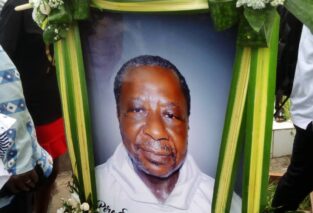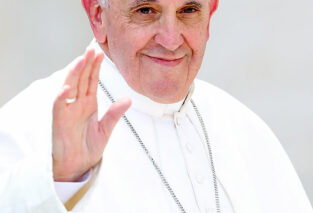During important events in Catholic churches in just about every diocese of Cameroon — for example, at Christmas, Easter, parish feast days, pastoral visits of the local bishop, etc, — the Lectionary, that is the book from the where the Word of God is proclaimed to the assembly, is usually brought to the Altar in a procession. Women groups generally lead the procession, which can take various forms. The most common is for two members of the lectionary procession team to walk the whole length of the church, from the entrance to the Altar, one of them striking a gong at regular intervals, and the other announcing to the congregation that the Word of God is about to make its way into the church. At times, two members, each bearing a peace plant, walk in silence from the entrance to the Altar and back to the entrance where the others are waiting.
Shortly thereafter, the choir intones a rhythmic song to the accompaniment of drums and other musical instruments. Then the procession begins, with members dancing to the rhythm of the music. If you’re some distance away, you can always tell where the Lectionary is by the peace plants covering the bearer. Before each procession begins, I almost always ask God to urge those women to do it a little faster. But, as if to annoy me more, the pace would almost always slacken as the dancers ululate to the sky, with the whole church picking up the cue with great joy.
Lord, help my impatience!
My impatience then bubbles over and I become fidgety and restlessly vocal in my protest against the slow nature of the procession to whoever may be standing near me. The other day I turned to protest to a certain woman near me when she, thinking I was appreciating the whole show, nodded her head and gave a thumbs-up sign of appreciation before emitting a siren-like sound that came from deep down her throat. I stood watching her in stunned silence.
Father Moses Tazoh, the parish priest of Muyuka parish in the Buea Diocese, and the former Editor-in-Chief of the Catholic monthly publication, Cameroon Panorama, speaks for me when he writes: “During liturgical celebrations, certain things about the lectionary procession usually take my attention away from the solemnity of the celebration. One is the slow pace….. I get the impression that the dancers … are so caught up with the rhythm of the dance … that they forget themselves and the fact that they have an urgent message to deliver” (Cameroon Panorama No 619, May 2009, p. 4). And he is right, Father Moses!
One step forward, two steps backward.
The other day, when the procession finally reached the Altar and, I was about to breathe a sigh of relief, the lead dancer, for one strange reason or another, decided to dance backwards, pushing back the whole group almost to the middle of the church, from where they again began to dance to the Altar. I just stopped short of flinging my missal at the neighbour ahead of me, so furious I was. This Bafia-like dance of one step forward, two steps backwards is a source of great distress for some of us.
I always commit sins of anger each time I am in church and the lectionary procession takes too long to reach its goal. Why, on God’s good earth, would people take a good 20 minutes to bring God’s Word to his Altar for us to listen to? What are those shouts, shrieks and ululations women always send out, disturbing the peace we should all have at Mass as we wait to hear God’s Word proclaimed to us?
Ideal lectionary procession
What do I see as the “ideal” lectionary procession, you may be asking yourself? Before you start to think that I’m just being too picky on those who do the commendable job of bringing God’s Word to His people – which seems to be so greatly appreciated by the congregation – from the shouts and screams that usually accompany them, let me tell you what I’ll like to see in our churches. I saw an “ideal” lectionary procession at the Metropolitan Cathedral of Bamenda during the celebration of the 75th anniversary of the arrival of the Mill Hill Fathers in Cameroon. That was several years ago.
It was an all men’s affair. Men dressed in the typical attire of the Samba group — a men’s war group typical of many north-western cultures– brought the Word of God to the Altar. In fact, the cathedral was dead silent when the announcer informed us that God’s Word was making its way among His people. We all stood up, as we should when God’s Word is walking among us. Then I saw coming up the aisle to the Altar a group of about ten men, colourfully dressed in the Samba multi-colour dress, each carrying a spear and some of them with machetes sheathed in scabbards. Beat your swords into their ploughshares, you could almost hear the prophet Isaiah saying to humanity that morning from the Saint Joseph Metropolitan Cathedral of Bamenda. Then four of their counterparts bore the Word of God on a bamboo chair on their shoulders. A few minutes later, the procession had reached the Altar and the then Occupant of the Metropolitan See of Bamenda, Father Paul Verdzekov, today with his Maker, came down from the Altar, received God’s Word and handed it over to one of his priests, who proclaimed it to God’s people in total silence. I have rarely felt such solemnity before, during and after a lectionary procession.
Let God’s people rejoice!
Lest I be misunderstood, I’m not, by any means, implying that all lectionary processions should be without vibrant music, song and dance. No, not at all! Let the music play on! Let the harp, the xylophones, the guitar and the drums send God’s people dancing as they welcome His Word with audible explosions of joy; but, for heaven’s sake, can the procession just be a little faster than it usually is the case in many of our churches?
Lectionary procession dancers, please, have pity on some of us, whom you enrage so much with those lengthy dances from the back of the church to the front of the Altar to bring God’s people his Word; all for the greater glory of God Almighty. Amen.
Douala, March 25, 2011


